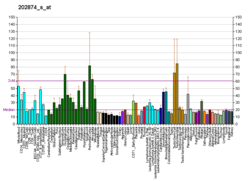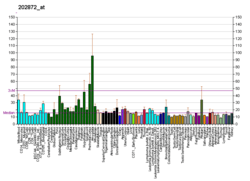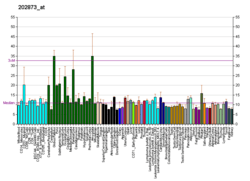ATP6V1C1
V-type proton ATPase subunit C 1 is an enzyme that in humans is encoded by the ATP6V1C1 gene.[5][6][7]
This gene encodes a component of vacuolar ATPase (V-ATPase), a multisubunit enzyme that mediates acidification of intracellular compartments of eukaryotic cells. V-ATPase dependent acidification is necessary for such intracellular processes as protein sorting, zymogen activation, receptor-mediated endocytosis, and synaptic vesicle proton gradient generation. V-ATPase is composed of a cytosolic V1 domain and a transmembrane V0 domain. The V1 domain consists of three A and three B subunits, two G subunits plus the C, D, E, F, and H subunits. The V1 domain contains the ATP catalytic site. The V0 domain consists of five different subunits: a, c, c', c'', and d. Additional isoforms of many of the V1 and V0 subunit proteins are encoded by multiple genes or alternatively spliced transcript variants. This gene is one of two genes that encode the V1 domain C subunit proteins and is found ubiquitously. This C subunit is analogous but not homologous to gamma subunit of F-ATPases. Previously, this gene was designated ATP6D.[7]
In melanocytic cells ATP6V1C1 gene expression may be regulated by MITF.[8]
References
- 1 2 3 GRCh38: Ensembl release 89: ENSG00000155097 - Ensembl, May 2017
- 1 2 3 GRCm38: Ensembl release 89: ENSMUSG00000022295 - Ensembl, May 2017
- ↑ "Human PubMed Reference:".
- ↑ "Mouse PubMed Reference:".
- ↑ van Hille B, Vanek M, Richener H, Green JR, Bilbe G (Jan 1994). "Cloning and tissue distribution of subunits C, D, and E of the human vacuolar H(+)-ATPase". Biochem Biophys Res Commun. 197 (1): 15–21. doi:10.1006/bbrc.1993.2434. PMID 8250920.
- ↑ Smith AN, Lovering RC, Futai M, Takeda J, Brown D, Karet FE (Oct 2003). "Revised nomenclature for mammalian vacuolar-type H+ -ATPase subunit genes". Mol Cell. 12 (4): 801–3. doi:10.1016/S1097-2765(03)00397-6. PMID 14580332.
- 1 2 "Entrez Gene: ATP6V1C1 ATPase, H+ transporting, lysosomal 42kDa, V1 subunit C1".
- ↑ Hoek KS, Schlegel NC, Eichhoff OM, et al. (2008). "Novel MITF targets identified using a two-step DNA microarray strategy". Pigment Cell Melanoma Res. 21 (6): 665–76. doi:10.1111/j.1755-148X.2008.00505.x. PMID 19067971.
External links
- Human ATP6V1C1 genome location and ATP6V1C1 gene details page in the UCSC Genome Browser.
Further reading
- Finbow ME, Harrison MA (1997). "The vacuolar H+-ATPase: a universal proton pump of eukaryotes". Biochem. J. 324 (3): 697–712. doi:10.1042/bj3240697. PMC 1218484. PMID 9210392.
- Stevens TH, Forgac M (1998). "Structure, function and regulation of the vacuolar (H+)-ATPase". Annu. Rev. Cell Dev. Biol. 13: 779–808. doi:10.1146/annurev.cellbio.13.1.779. PMID 9442887.
- Nelson N, Harvey WR (1999). "Vacuolar and plasma membrane proton-adenosinetriphosphatases". Physiol. Rev. 79 (2): 361–85. PMID 10221984.
- Forgac M (1999). "Structure and properties of the vacuolar (H+)-ATPases". J. Biol. Chem. 274 (19): 12951–4. doi:10.1074/jbc.274.19.12951. PMID 10224039.
- Kane PM (1999). "Introduction: V-ATPases 1992-1998". J. Bioenerg. Biomembr. 31 (1): 3–5. doi:10.1023/A:1001884227654. PMID 10340843.
- Wieczorek H, Brown D, Grinstein S, et al. (1999). "Animal plasma membrane energization by proton-motive V-ATPases". BioEssays. 21 (8): 637–48. doi:10.1002/(SICI)1521-1878(199908)21:8<637::AID-BIES3>3.0.CO;2-W. PMID 10440860.
- Nishi T, Forgac M (2002). "The vacuolar (H+)-ATPases--nature's most versatile proton pumps". Nat. Rev. Mol. Cell Biol. 3 (2): 94–103. doi:10.1038/nrm729. PMID 11836511.
- Kawasaki-Nishi S, Nishi T, Forgac M (2003). "Proton translocation driven by ATP hydrolysis in V-ATPases". FEBS Lett. 545 (1): 76–85. doi:10.1016/S0014-5793(03)00396-X. PMID 12788495.
- Morel N (2004). "Neurotransmitter release: the dark side of the vacuolar-H+ATPase". Biol. Cell. 95 (7): 453–7. doi:10.1016/S0248-4900(03)00075-3. PMID 14597263.
- Nelson H, Mandiyan S, Noumi T, et al. (1990). "Molecular cloning of cDNA encoding the C subunit of H(+)-ATPase from bovine chromaffin granules". J. Biol. Chem. 265 (33): 20390–3. PMID 2147024.
- Xu XR, Huang J, Xu ZG, et al. (2002). "Insight into hepatocellular carcinogenesis at transcriptome level by comparing gene expression profiles of hepatocellular carcinoma with those of corresponding noncancerous liver". Proc. Natl. Acad. Sci. U.S.A. 98 (26): 15089–94. doi:10.1073/pnas.241522398. PMC 64988. PMID 11752456.
- Strausberg RL, Feingold EA, Grouse LH, et al. (2003). "Generation and initial analysis of more than 15,000 full-length human and mouse cDNA sequences". Proc. Natl. Acad. Sci. U.S.A. 99 (26): 16899–903. doi:10.1073/pnas.242603899. PMC 139241. PMID 12477932.






